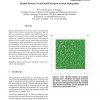Free Online Productivity Tools
i2Speak
i2Symbol
i2OCR
iTex2Img
iWeb2Print
iWeb2Shot
i2Type
iPdf2Split
iPdf2Merge
i2Bopomofo
i2Arabic
i2Style
i2Image
i2PDF
iLatex2Rtf
Sci2ools
WIAS
2010
2010
Spatial pattern growth and emergent animat segregation
Spatial agent models can be used to explore self-organising effects such as pattern growth and segregation. We employ our predator-prey model to study these emergent behaviours in systems of up to around one million animat agents. We compare the patterns, structures and emergent properties of our model with the spatial patterns formed in non-intelligence based models that are governed only by statistical mechanics. We describe an emergent species separation effect found amongst the prey animats when we employ a simple genetic marker to track animats and introduce a microscopic breeding preference. We present results using quantitative metrics such as the animal spatial density and the pair-wise density-density correlation function. We discuss how these metrics can be used to categorize different self-organisational model regimes.
| Added | 31 Jan 2011 |
| Updated | 31 Jan 2011 |
| Type | Journal |
| Year | 2010 |
| Where | WIAS |
| Authors | Kenneth A. Hawick, C. J. Scogings |
Comments (0)

